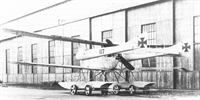
| Самолеты (сортировка по:) | |||||
| Страна | Конструктор | Название | Год | Фото | Текст |
Friedrichshafen FF34

|
Страна: Германия Год: 1915
|
| Friedrichshafen - FF33 - 1915 - Германия | <– | –> | Friedrichshafen - FF35 - 1915 - Германия |
 |
J.Herris - Friedrichshafen Aircraft of WWI /Centennial Perspective/ (21) |
| The sole prototype Friedrichshafen FF34 was built to explore the pusher configuration for reconnaissance floatplanes. |
 |
O.Thetford, P.Gray - German Aircraft of the First World War /Putnam/ |
 |
J.Herris - Friedrichshafen Aircraft of WWI /Centennial Perspective/ (21) |
| This view of the Friedrichshafen FF34 shows the careful attention given to minimize the frontal area to keep drag low despite the pusher configuration. |
 |
J.Herris - Friedrichshafen Aircraft of WWI /Centennial Perspective/ (21) |
| The prototype Friedrichshafen FF34 first flew in early January 1916 and was delivered on 24 January 1916. Like most pusher designs the observer sat in the forward cockpit where he had an excellent field of view and field of fire for his flexible machine gun. Designed as class CHFT, the FF34 also carried a wireless transmitter and receiver. |
 |
J.Herris - Friedrichshafen Aircraft of WWI /Centennial Perspective/ (21) |
| Above: This view of the Friedrichshafen FF34 shows the careful attention given to minimize the frontal area to keep drag low despite the pusher configuration. |
 |
O.Thetford, P.Gray - German Aircraft of the First World War /Putnam/ |
| Friedrichshafen FF 34 |
 |
J.Herris - Friedrichshafen Aircraft of WWI /Centennial Perspective/ (21) |
| The prototype Friedrichshafen FF34 at the airship hangar on Lake Constance. |
 |
J.Herris - Friedrichshafen Aircraft of WWI /Centennial Perspective/ (21) |
| The prototype Friedrichshafen FF34 inside the airship hangar on Lake Constance. |
 |
J.Herris - Friedrichshafen Aircraft of WWI /Centennial Perspective/ (21) |
| The Friedrichshafen FF34 afloat on Lake Constance. Like all Friedrichshafen aircraft, the FF34 was carefully designed and built using the conventional wire-braced, fabric-covered wood structure of the time. Friedrichshafen's structures were robust but not innovative. Unfortunately, the tail booms were not robust enough for operational use. |